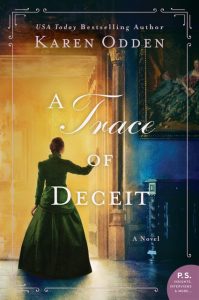 A Trace of Deceit is the third Victorian mystery by Karen Odden, who has taught at the University of Michigan. It is a suspenseful, compelling novel set in London’s art world in 1875. The protagonist, a talented young painter named Annabel Rowe, is one of the few female students at the Slade School of Art, one of the only art schools to admit women at the time. When she goes to visit her brother Edwin, she finds the police in his rooms, searching through his belongings. Of course, Edwin has been murdered, and Annabel, while shocked, is not wholly surprised. Edwin, a brilliant young artist, has led a dissolute life of gambling and drug use, and had recently been released from prison, where he spent time for forgery. Annabel and Edwin were close as children, but had grown apart after Edwin left for boarding school, and he had hoped to rebuild his relationship with her. Annabel wants to believe Edwin had reformed, but she is not always so sure, and she blames him for their parents’ deaths, because they died of a fever they supposedly caught from Edwin after one of his visits to an opium den.
A Trace of Deceit is the third Victorian mystery by Karen Odden, who has taught at the University of Michigan. It is a suspenseful, compelling novel set in London’s art world in 1875. The protagonist, a talented young painter named Annabel Rowe, is one of the few female students at the Slade School of Art, one of the only art schools to admit women at the time. When she goes to visit her brother Edwin, she finds the police in his rooms, searching through his belongings. Of course, Edwin has been murdered, and Annabel, while shocked, is not wholly surprised. Edwin, a brilliant young artist, has led a dissolute life of gambling and drug use, and had recently been released from prison, where he spent time for forgery. Annabel and Edwin were close as children, but had grown apart after Edwin left for boarding school, and he had hoped to rebuild his relationship with her. Annabel wants to believe Edwin had reformed, but she is not always so sure, and she blames him for their parents’ deaths, because they died of a fever they supposedly caught from Edwin after one of his visits to an opium den.
At first Annabel thinks Edwin’s past has caught up with him, but when a valuable 18th-century French painting, a portrait of Madame de Pompadour that Edwin had been restoring before it went up for auction goes missing from his rooms, she realizes Edwin was caught up in a more dangerous game than she imagined. Felix, a close friend of Annabel’s father, who works for Bettridge’s, an auction house that aspires to be a rival to Christie’s and Sotheby’s, informs Annabel of the theft and tells her if the painting is not recovered, he will be held responsible and lose his position. Odden’s descriptions of Victorian art auctions, and how the auction houses operated, are fascinating. She used to work for Christie’s, so she writes from experience.
Annabel decides to work together with Inspector Matthew Hallam of Scotland Yard in his investigation of Edwin’s murder, and he agrees because she is Edwin’s only relative and because of her knowledge of the art world. It turns out that the widow who put the painting up for auction might not be the legal owner. The stepson of a recently deceased nobleman, Lord Sibley, claims that the painting belonged to his stepfather and was destroyed when the Pantechnicon, a building where the wealthy stored their valuables when they traveled, burned down the previous year. Is the painting stolen from Edwin’s rooms a forgery? Or could the original have been removed from the Pantechnicon before the fire? And how did it come into the possession of the widow who put it up for auction? She claims her late husband meant it to be a gift for her, but it is possible he was holding it for someone else. Her husband died in a carriage accident, but Annabel and Matthew begin to wonder if his death and that of Lord Sibley, who died after a sudden illness at around the same time, were actually murder.
While searching through Edwin’s sketchbooks, Annabel discovers that the drawings he made while at boarding school became increasingly disturbing, and one sketchbook from that time is missing. She realizes something terrible happened to him at school, and she and Matthew travel to the school to find answers. What does Edwin’s experience at school have to do with his murder and the theft of the painting? Of course there is a connection, but I won’t spoil it here. All I will say was that I guessed what happened to Edwin at school, but I didn’t figure out until the end how it tied into the murder.
Inevitably, there is a romance between Annabel and Matthew, but it is not the main focus of the novel. Their relationship develops gradually and believably. The two of them use contrasting approaches to solving the murder, and they complement each other. Annabel sees things with an artist’s eye, and captures moments when people’s feelings betray them, while Matthew takes a more logical approach.
One thing I found especially moving was Annabel’s early memories of Edwin when they were children. They are happy memories, in contrast with the dark events that are to come. But Annabel wonders whether her memories are of what actually happened, or of what she would like to have happened. An important theme of the book is how our memories, especially childhood memories, can deceive us. We think we remember something happening one way, when it actually happened differently. But which is more important: knowing the truth or clinging to memories of loved ones, even if the memories are deceptive? The reader is left with much to think about. I thought of some of my own childhood memories and how, when I looked through old pictures, it turned out the events didn’t happen exactly as I thought.
Annabel is a wonderful protagonist, and a compassionate and caring person. She is talented, but not extraordinarily so, and Edwin was actually the more talented of the two. Odden could so easily have made her a genius who, because she was a woman, was not given the opportunities her brother had, but she doesn’t, and I think this makes Annabel more human and easier to relate to. Matthew is another great character, strong and intelligent, and willing to trust Annabel when his chief inspector is suspicious of her.
I had not read Odden’s two previous novels, A Lady in the Smoke and A Dangerous Duet, but it didn’t matter, because each novel has a different protagonist, and A Trace of Deceit stands on its own. The protagonist of A Dangerous Duet is Matthew’s sister, Nell Hallam, a concert pianist, so I’m sure Matthew plays an important role in that novel. In A Trace of Deceit, he refers to mistakes he made in a previous case, so I assume he is speaking of the events of the previous novel. Nell is mentioned in A Trace of Deceit but doesn’t actually appear. Now I would like to read the other two novels, especially A Dangerous Duet, because Nell sounds like a fascinating character. I hope Annabel and Matthew reappear in future novels. I highly recommend A Trace of Deceit to fans of Anne Perry, Tasha Alexander, and Anna Lee Huber. — Vicki Kondelik
*****************************
 Vicki Kondelik is a cataloger at the University of Michigan’s Graduate Library, and edits their book review blog, Lost in the Stacks. She writes book reviews for the Historical Novel Society, and is currently writing a historical novel. She has been an avid mystery reader for a long time.
Vicki Kondelik is a cataloger at the University of Michigan’s Graduate Library, and edits their book review blog, Lost in the Stacks. She writes book reviews for the Historical Novel Society, and is currently writing a historical novel. She has been an avid mystery reader for a long time.